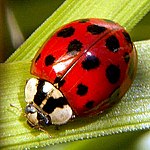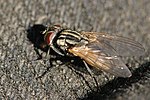Entomology/Common insects
Table of Contents[edit | edit source]
- Introduction
- What are insects?
- Common insects
- Other insects
- What are arachnids?
- Common arachnids
- Other arachnids
Introduction[edit | edit source]
There are about 27 orders of insects. With new genetic and other information, the arrangement and number of the orders has been changing and may continue to do so. In this brief guide, we're only going to cover a few of those more commonly important to humans.
In descending order of number of species, the orders of insects we will cover are:
- Coleoptera (Beetles, about 400,000 species)
- Lepidoptera (Butterflies and moths, about 150,000 species)
- Hymenoptera (Wasps, bees, and ants, about 130,000 species)
- Diptera (Flies, about 120,000 species)
- Hemiptera (true bugs, about 82,000 species)
- Orthoptera (Grasshopers, crickets, and mantids, about 20,500 species)
- Odonata (Dragonflies and damselflies, about 5,500 species)
Coleoptera[edit | edit source]
Coccinella septempunctata[edit | edit source]

The seven-spotted ladybird (or ladybug) is a very common beetle found in both North America and Europe, and is an important predator of aphids.

Harmonia axyridis[edit | edit source]

The Asian lady beetle (or harlequin ladybird) is a species that is similar to C septempunctata. This species is also an important predator of aphids, however is causes more problems to humans, because they freqently overwinter in homes. The species is originally from East Asia, but was introduced to North America and Europe.

Lepidoptera[edit | edit source]
Papilio[edit | edit source]
The genus Papilio includes many species that are well-known around the world. Such species are charchterised by their "swallowtails" for which they are named.
-
Papilio glaucus, Eastern Tiger Swallowtail
-
Papilio machaon, Old World Swallowtail
-
Papilio xuthus, Asian swallowtail
-
Papilio polyctor, Common Peacock
Danaus plexippus[edit | edit source]

The Monarch butterfly is common in North America, as well as New Zealand and Australia. It is one of the few milkweed butterflies in North America. As larva, the monarch feeds on milkweed, which is poisonous. This poison persists in the monarch as an adult, which provides it protection from many predators. This is so successful, that Limenitis archippus (in the same family, but in a different subfamily) mimics the monarch so that it is not eaten by predators.
Hymenoptera[edit | edit source]
-
Vespula germanica
-
Apis mellifera
-
Iridomyrmex purpureus
Vespula[edit | edit source]
Yellowjackets are wasps that can be found in both Europe and North America. There are two particular species: Vespula germanica and Vespula vulgaris. These are known as the German wasp and the common wasp, respectively. Yellowjackets are social insects— a queen builds a nest, usually of wood, and then lays eggs. When the eggs hatch, the larvae are carnivorous, and feed on other insects. Adult wasps feed on nectar. Though, often considered pests or harmful to humans, wasps are important predators of many other pests such as flies.
Apis[edit | edit source]
Honeybees are important plant pollinators.
Diptera[edit | edit source]
Musca domestica[edit | edit source]

The housefly is very common, and frequently lives with humans. Flies, like butterflies, undergo complete metamorphosis. In their larval stage they are called maggots, in which they will feed on organic matter. After three instars, they become pupae, then emerge as adults. Like other insects, the purpose of the adult form is for mating— flies live only about one month after maturation. Flies have sponging mouth-parts. They can only consume liquids, but can also apply digestive fluids to solids, and then ingest them as fluids.
Culicidae[edit | edit source]
Mosquitos are known particularly for spreading disease. Mosquitos, like other flies, undergo compete metamorphosis. Eggs, larvae, and pupae develop in water, but the adult is terrestrial. The larvae also develop in three instars. The pupae then float to the surface of the body of water, so that the adults can emerge into the air.
-
Culiseta longiareolata
-
Culex quinquefasciatus
-
Anopheles stephensi
Hemiptera[edit | edit source]
True bugs.
Orthoptera[edit | edit source]
Grasshopers, crickets, and mantids
Odonata[edit | edit source]
Dragonflies and Damselflies









